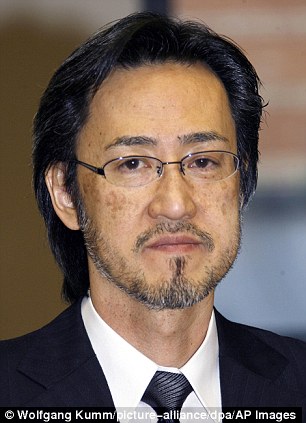Why On Earth Would A Scientist Create A New Flu Virus That Could Kill All Of Humanity?
Reports say that a controversial scientist has created a strain of the flu viruses that evades the human immune system and could unleash an untreatable pandemic. But are the reports exaggerated?
This is Yoshihiro Kawaoka, a controversial flu researcher who has modified the flu virus responsible for the 2009 pandemic to allow it evade the human immune system
Yoshihiro Kawaoka of the University of Wisconsin-Madison has genetically manipulated the 2009 strain of pandemic flu in order for it to “escape” the control of the immune system’s neutralising antibodies, effectively making the human population defenceless against its reemergence.
Most of the world today has developed some level of immunity to the 2009 pandemic flu virus, which means that it can now be treated as less dangerous “seasonal flu”.
telegraph.co.ukThe Independent said that Professor Kawaoka intentionally set out to see if it was possible to convert it to a pre-pandemic state in order to analyse the genetic changes involved
This 2009 Centers For Disease Control and Prevention handout image taken through a microscope, shows a negative-stained image of the swine flu virus H1N1 strain
Image via rt.comThe study is not published, however some scientists who are aware of it are horrified that Dr Kawaoka was allowed to deliberately remove the only defence against a strain of flu virus that has already demonstrated its ability to create a deadly pandemic that killed as many as 500,000 people in the first year of its emergence.
Professor Kawaoka has so far kept details of the research out of the public domain but admitted today that the work is complete and ready for submission to a scientific journal. The experiment was designed to monitor the changes to the 2009 H1N1 strain of virus that would enable it to escape immune protection in order to improve the design of vaccines, he said.
“Through selection of immune escape viruses in the laboratory under appropriate containment conditions, we were able to identify the key regions [that] would enable 2009 H1N1 viruses to escape immunity,” Professor Kawaoka said in an email. “Viruses in clinical isolates have been identified that have these same changes in the [viral protein]. This shows that escape viruses emerge in nature and laboratory studies like ours have relevance to what occurs in nature,” he added.
telegraph.co.ukThe Guardian reports that the virus closely resembles the 1918 Spanish flu strain that killed an estimated 50 million people in an experiment labelled as "crazy" by opponents
"The work they are doing is absolutely crazy. The whole thing is exceedingly dangerous," said Lord May, the former president of the Royal Society and one time chief science adviser to the UK government. "Yes, there is a danger, but it's not arising form the viruses out there in the animals, it's arising from the labs of grossly ambitious people."
Influenza viruses circulate freely in wild bird populations. While most remain in chickens, ducks and other birds, occasionally strains mutate into a form that can infect humans.
The avian flu strain H5N1, seen in gold, grown in Madin-Darby canine kidney cells. It has killed at least 386 people since 2003
Image via guim.co.ukThe H5N1 bird flu strain has killed at least 386 people since 2003, according to WHO figures. The Spanish 1918 flu is thought to have come from birds too.
rt.comWriting in the journal Cell Host and Microbe Yoshihiro Kawaoka describes how his team analysed various bird flu viruses and found genes from several strains that were very similar to those that made up the 1918 human flu virus. They combined the bird flu genes into a single new virus, making a new pathogen that was only about 3% different from the 1918 human virus.
The freshly made virus – the first of several the team created – was more harmful to mice and ferrets than normal bird flu viruses, but not as dangerous as the 1918 strain. It did not spread between ferrets and none of the animals died. But the scientists went on to mutate the virus, to see what changes could make it spread. Seven mutations later, they had a more dangerous version that spread easily from animal to animal in tiny water droplets, the same way flu spreads in humans.
cell.comHowever, newscientist.com, which has some doubts over the reporting in the UK papers about the research, has since published a bunch of FAQs regarding the newly created virus
How worried should we be about the newly created viruses?
Not much at all – and certainly not about either of these claims that Yoshihiro Kawaoka has "deliberately created a pandemic strain of flu that can evade the human immune system", and that the work recreates the deadly 1918 pandemic flu virus in a form that resists vaccines. But there might be cause for concern in the way this kind of research is being regulated.
newscientist.comDid professor Kawaoka actually make a copy of the deadly 1918 pandemic virus that evades human immunity and vaccines?
No. The work looked at the potential evolution of a current strain of winter flu. Kawaoka has told New Scientist that he was exposing the currently circulating winter flu virus descended from the 2009 swine flu to the immune reactions it induces in people and animals, to see what mutants emerge. "This kind of work has been done for more than 30 years, to help in the selection of vaccine strains," he says.
newscientist.comWhy is such work necessary?
Flu is different from diseases like measles, which – if they don't kill you – leave you immune for life. You can catch flu again and again because it evolves so fast. After a particular flu virus has dominated a few winter flu seasons, most people's immune systems recognise and kill it. At that point, a mutant of that virus will emerge that is slightly different to the original flu. This becomes the new dominant winter flu. This process is called "immune escape" and it is why winter flu is often mild: the virus isn't very different from the last flu we caught, so we have some immunity – just not quite enough to stop it completely.
newscientist.comEvery now and then, though, a new flu breaks out to which most people have no immunity. This is a pandemic, and it is usually more deadly than ordinary flu. The last one was the swine flu pandemic of 2009. After the initial outbreak a pandemic virus keeps circulating as winter flu, becoming less nasty as more people are exposed and get immunity to it – whereupon it starts producing escape mutants like ordinary flu does. The 2009 virus is now starting to do that.
newscientist.comThis constant evolution means the flu vaccine has to be redesigned every year for whatever new mutant comes along. Because it takes six months to make, virologists and manufacturers must guess well in advance which viruses circulating this winter are likely to dominate next winter. Since the 1980s this process has been aided by experiments in which the current flu is exposed to antibodies and other immune molecules from people or experimental animals, to see what mutants evolve.
newscientist.comSo this work has nothing to do with the 1918 pandemic flu that killed more than 50 million people worldwide?
Both the 1918 flu and the 2009 pandemic virus belong to the same family of flu, but they are very different – the 2009 virus isn't nearly as lethal as the 1918 flu. Itdominated this year's winter flu season in the northern hemisphere. There is little reason to think the lab-generated mutants will be more virulent.
newscientist.comKawaoka has done recent work in which he compared viruses resembling it now circulating in birds to a reconstructed 1918 virus, to assess whether it could re-emerge. He concluded it might. That work was criticised for creating dangerous viruses that might not otherwise evolve; it was also done with stringent security measures to prevent viruses escaping.
newscientist.comSo is there a problem?
Yes. The problem is not this particular research, but the secrecy that can surround such work. Kawaoka has sent his 2009 virus work to a leading journal, which prevents him from saying much about it before the work appears in print.
newscientist.comAnd the work was approved by US funding agencies under specific rules for this kind of research, but that process is not open to public scrutiny, even though experts differ on potential risks and benefits.
newscientist.comBoth kinds of secrecy have led to misleading public reports. That could make it harder for researchers to do the really important work we need to defend ourselves from flu – which is evolving, whatever we do.
newscientist.com



